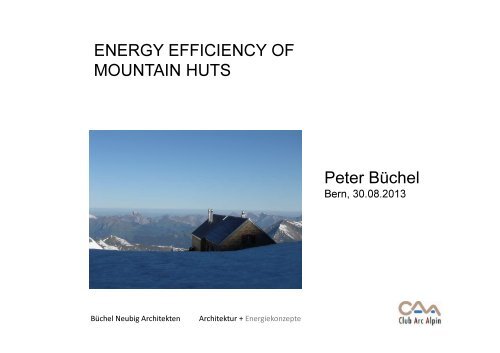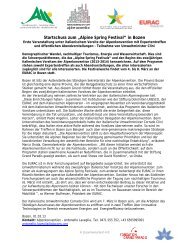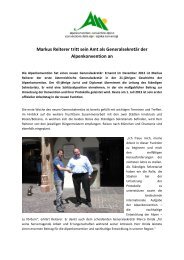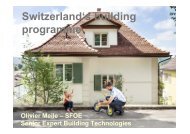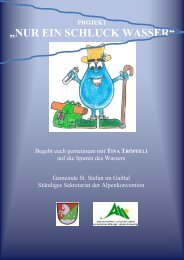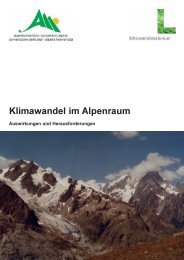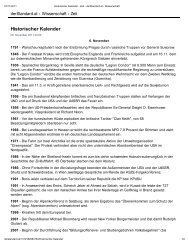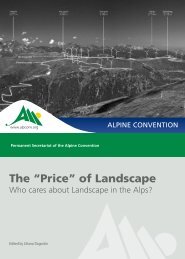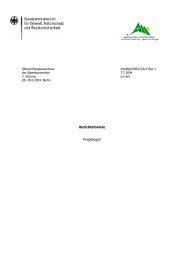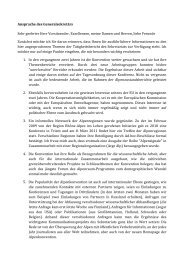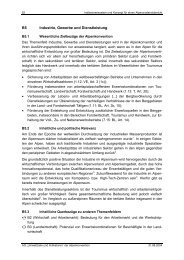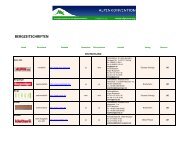Energy efficiency Alpine huts, Peter Büchel
Energy efficiency Alpine huts, Peter Büchel
Energy efficiency Alpine huts, Peter Büchel
Create successful ePaper yourself
Turn your PDF publications into a flip-book with our unique Google optimized e-Paper software.
ENERGY EFFICIENCY OF<br />
MOUNTAIN HUTS<br />
<strong>Peter</strong> <strong>Büchel</strong><br />
Bern, 30.08.2013<br />
<strong>Büchel</strong> Neubig Architekten Architektur + Energiekonzepte
<strong>Alpine</strong> ‘Passivhaus‘ buildings<br />
Landmark projects in the <strong>Alpine</strong> zone take the<br />
discussion to the <strong>efficiency</strong> of building <strong>huts</strong> in Europe<br />
1. Dobratsch Gipfelhaus OeAV<br />
2. Schiestelhaus ÖTK<br />
3. New Monte-Rosa-Hut SAC<br />
4. Refuge Dôme du Gôuter CAF<br />
<strong>Büchel</strong> Neubig Architekten Architektur + Energiekonzepte
‘Passive‘ does not necessarily mean efficient!<br />
- the question of <strong>efficiency</strong> is not explicitely<br />
incorporated in the principle of the ‘Passivhaus‘<br />
- a ‘Passivhaus‘ requires more building components<br />
and systems.<br />
- The question whether the material and technical<br />
effort pay off in relation to the actual energy saving<br />
has not been concluded up to today.<br />
<strong>Büchel</strong> Neubig Architekten Architektur + Energiekonzepte
Can minimising mean more <strong>efficiency</strong>?<br />
- is reduction more efficient than high tech ?<br />
- is a low tech hut more efficient than a ‘passive‘ one ?<br />
- is it necessary to insulate a summer hut?<br />
- does a building which remains unused for 250 days need<br />
to be a high tech building tailored to perform at -25°C?<br />
<strong>Büchel</strong> Neubig Architekten Architektur + Energiekonzepte
Questions without straight forward answers!<br />
- no specific calculation method exisits today<br />
- a tool would need to cover specific areas like:<br />
electricity generation, sewage treatment, transport,<br />
supplies etc.)<br />
- partial use of <strong>huts</strong> is very common<br />
- climatic data very difficult (e.g. heating periods)<br />
<strong>Büchel</strong> Neubig Architekten Architektur + Energiekonzepte
Project brief EEH<br />
- generation of a calculation tool specific to <strong>huts</strong><br />
- conceptualise specific set of requirements<br />
- test calculation tool in 4 case studies, i.e. 4 <strong>huts</strong><br />
- user group: experts (architects / energy<br />
consultants, engineers)<br />
<strong>Büchel</strong> Neubig Architekten Architektur + Energiekonzepte
Question asked by EEH<br />
- <strong>Energy</strong> usage in operation<br />
- Efforts in relation to supplies<br />
- Efforts in relation to technology<br />
- Efforts in relation to creation / dismantling<br />
- CO2–assessment comparing usage and built volume<br />
- Evaluating component age (attenuating CO2 balance)<br />
<strong>Büchel</strong> Neubig Architekten Architektur + Energiekonzepte
Layers of assessment EEH<br />
Location data )<br />
Context )<br />
Building data ) incl. CO2 assessment<br />
Technical data ) embodied energy<br />
Operation data )<br />
Usage data )<br />
<strong>Büchel</strong> Neubig Architekten Architektur + Energiekonzepte
Choice of criteria for case studies<br />
Choice of 4 <strong>huts</strong> based on following criteria<br />
1. Different types (large to small)<br />
2. Well known and unknown (by assessors)<br />
3. Conversion, extension and at least 1 new built<br />
4. On varying heights, levels of access und<br />
use<br />
5. Different building construction methods<br />
6. Covering all types of energy generation<br />
<strong>Büchel</strong> Neubig Architekten Architektur + Energiekonzepte
Choice of case studies<br />
1. Olpererhütte DAV (site visit Sep 2012)<br />
Section:<br />
DAV Sektion Neumarkt<br />
Built in:<br />
2007 (repalcement)<br />
Height:<br />
2153m a.s.l.<br />
Access / climb: no vehical access / climb 2.0h<br />
Supplies:<br />
by helicopter and by foot (2.0h)<br />
<strong>Energy</strong> supply: comb. heat & power plant, PV cells<br />
Sewage treatment: membrane filter sewage plant<br />
Bed spaces:<br />
65 (beds and bunks)<br />
<strong>Büchel</strong> Neubig Architekten Architektur + Energiekonzepte
Choice of case studies<br />
2. Solsteinhaus OeAV (site visit Sep 2012)<br />
Section:<br />
OeAV Sektion Innsbruck<br />
Built in:<br />
2008 (most recent extension)<br />
Height:<br />
1805m a.s.l.<br />
Access / climb: no vehical access / climb 2.0h<br />
Supplies:<br />
by cable car (not com.) and foot (1.0h)<br />
<strong>Energy</strong> supply: comb. heat & power plant, PV cells<br />
Sewage treatment: Biological sewage plant (SBR)<br />
Bed spaces:<br />
108 (beds and bunks)<br />
<strong>Büchel</strong> Neubig Architekten Architektur + Energiekonzepte
Choice of case studies<br />
3. Wildstrubelhütte SAC (site visit July 2012)<br />
Section:<br />
SAC Sektionen Kaiseregg / Wildhorn<br />
Built in:<br />
1928 (building), 2002 (most recent extension)<br />
Height:<br />
2793m a.s.l.<br />
Access / climb: no vehical access / climb (3.0h)<br />
Supplies:<br />
by cable car (not commercially)<br />
<strong>Energy</strong> supply: Electricity grid / ventilation (Minergie Standard)<br />
Sewage treatment: TC plant Ecosphère<br />
Bed spaces:<br />
70 (bunks)<br />
<strong>Büchel</strong> Neubig Architekten Architektur + Energiekonzepte
Choice of case studies<br />
4. Rifugio Quintino Sella (site visit July 2013)<br />
Section:<br />
CAI Sektion Saluzzo<br />
Built in:<br />
1905 (Building), 1991 (most recent extension)<br />
Height:<br />
2640m a.s.l.<br />
Access / climb: no vehical access / climb (2.0h)<br />
Supplies :<br />
by helicopter and by foot (2.0h)<br />
<strong>Energy</strong> supply: power plant micro water power station<br />
Sewage treatment: 3-chamber-sedation<br />
Bed spaces:<br />
90 (beds and bunks)<br />
<strong>Büchel</strong> Neubig Architekten Architektur + Energiekonzepte
Project Structure EEH<br />
Project members => Members of Clubs CAA<br />
Project lead<br />
=> P. <strong>Büchel</strong>, BN-Arch<br />
Structure Assessment => P. <strong>Büchel</strong>, BN-Arch<br />
Data collection refuges => CAA, BN-Arch, KIT<br />
Data collection CO2 => Anna Kühlen, KIT<br />
Integration into system => Daniel Dahinden, BN-Arch<br />
Programming/Software => Daniel Dahinden<br />
<strong>Büchel</strong> Neubig Architekten Architektur + Energiekonzepte
Status of project EEH<br />
1. Project start April 2011<br />
2. Data matrix (Dummy) (06.11 – 03.12)<br />
3. Decision cooperation KIT (03.12)<br />
4. Assessment & calculation of programme basis (03. – 09.12)<br />
6. Data collection Wildstrubel, Solstein & Olperer (08. – 09.12)<br />
7. Reworking assessment / questionnaire (10. – 12.12)<br />
8. Generation of CO2e values and formulas (12.12 – 10.13)<br />
9. Calculation tool running in parts (since 06.13)<br />
10. Data collection Rif. Quinttino Sella (08.13)<br />
11. 2nd reworking assessment / questionnaire (08. – 09.13)<br />
<strong>Büchel</strong> Neubig Architekten Architektur + Energiekonzepte
Following tasks EEH<br />
- 2nd assessment of question – in progress<br />
- Adjustments to matrix based on last data collection - in progress<br />
- Critical assessment of building components based on data KIT<br />
– in progress<br />
- Extended programming of matrix - in progress<br />
- Support information for using matrix follows from 10.13 onwards<br />
<strong>Büchel</strong> Neubig Architekten Architektur + Energiekonzepte
Process of using the tool<br />
1. Collection of data on site<br />
2. Collection of basic data from the local section or main club<br />
3. Assessment mass balance of building (m2, m3, EBF, etc.)<br />
based on drawings and data collection<br />
3. Collection and integration of data from manuals, archives,<br />
etc.<br />
4. Examination of key data<br />
5. Start calcuation<br />
It is generally possible to test options, however a new project<br />
needs to be created for each option.<br />
<strong>Büchel</strong> Neubig Architekten Architektur + Energiekonzepte
Documents<br />
- Questionnaire for site visit (Word file or printed copy)<br />
- Assessment matrix (Excel)<br />
- Support & FAQs (.pdf )<br />
<strong>Büchel</strong> Neubig Architekten Architektur + Energiekonzepte
First results from tests of segments<br />
- definition for climatic location (HGT)<br />
incl. definition of days of operation (adjustments ongoing)<br />
- Generally speaking timber construction appears more efficient<br />
than masonry (CO2 savings wood has a clearly beneficial<br />
effect)<br />
<strong>Büchel</strong> Neubig Architekten Architektur + Energiekonzepte
First results from tests of segments<br />
- Threshold of <strong>efficiency</strong> of thermal insulation thickness not<br />
clearly defined as dependent on location and type of operation<br />
(only possible in complete version)<br />
- Mass balance of supply buildings is relevant<br />
- Transport system will give main indication, whereby it is still<br />
uncertain whether cable car or helicoptor preferable<br />
- Mass balance for sewage treatment is relevant<br />
<strong>Büchel</strong> Neubig Architekten Architektur + Energiekonzepte
The future of <strong>huts</strong> is more efficient<br />
The construction of mountain <strong>huts</strong> is far more complex<br />
than building in valleys and hence not directly transferable.<br />
What might seem right when constructing in valleys might not be<br />
in the high mountains – and reverse.<br />
Efficiency needs to be defined based on the specific location<br />
rather than by a generic method of calculation for heating/energy<br />
requirements (heating, etc).<br />
<strong>Büchel</strong> Neubig Architekten Architektur + Energiekonzepte
Things might be more efficient than they seem<br />
Our special thanks for great<br />
support of the energy project<br />
to:<br />
Anna Kühlen<br />
Georg Unterberger<br />
Robert Kolbitsch<br />
Georg Simeoni<br />
und the whole team of EEH<br />
Thank you for your attention<br />
<strong>Büchel</strong> Neubig Architekten Architektur + Energiekonzepte


